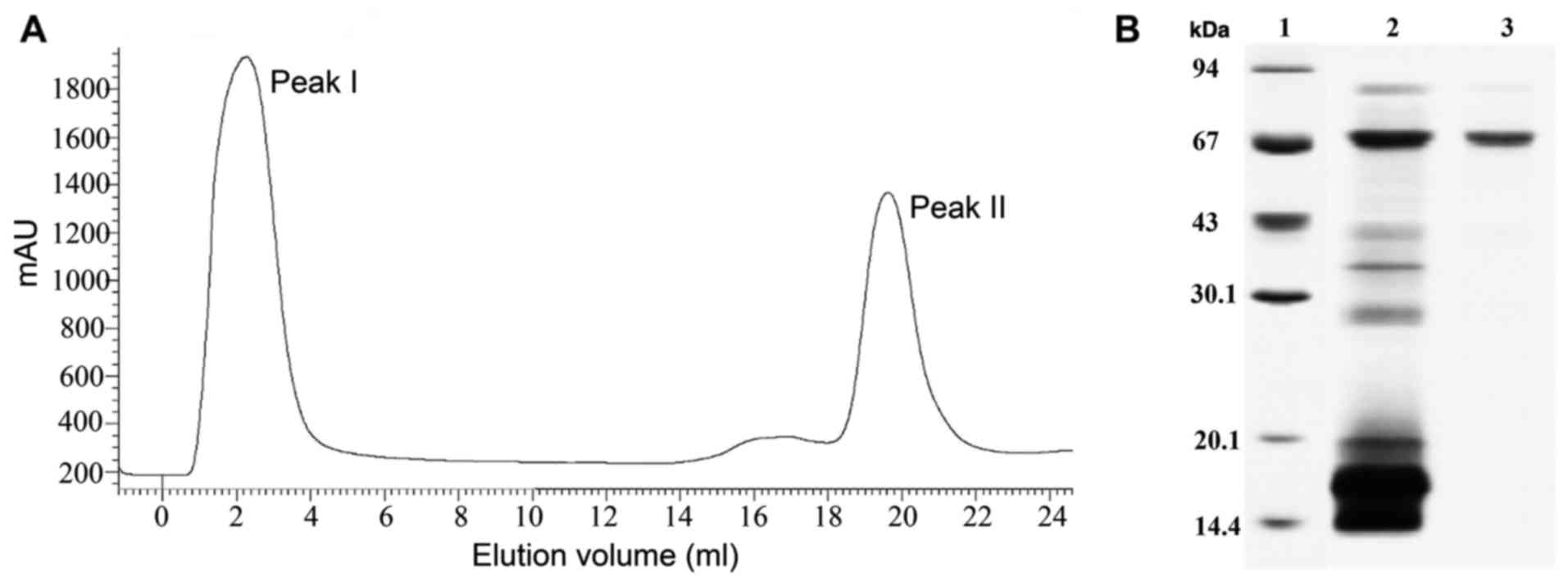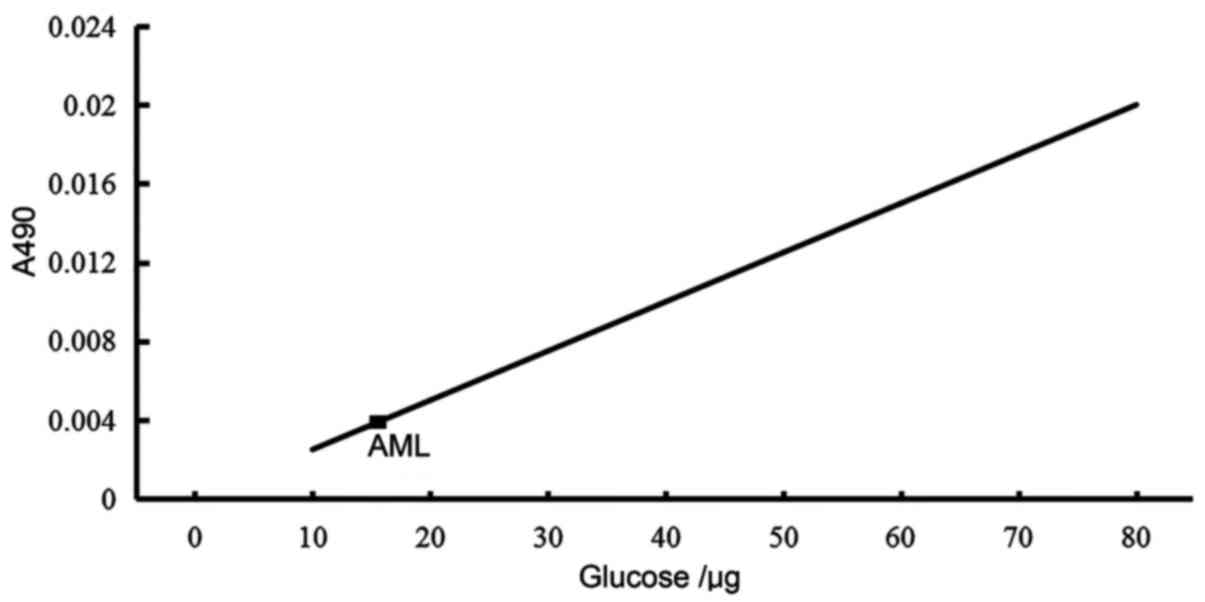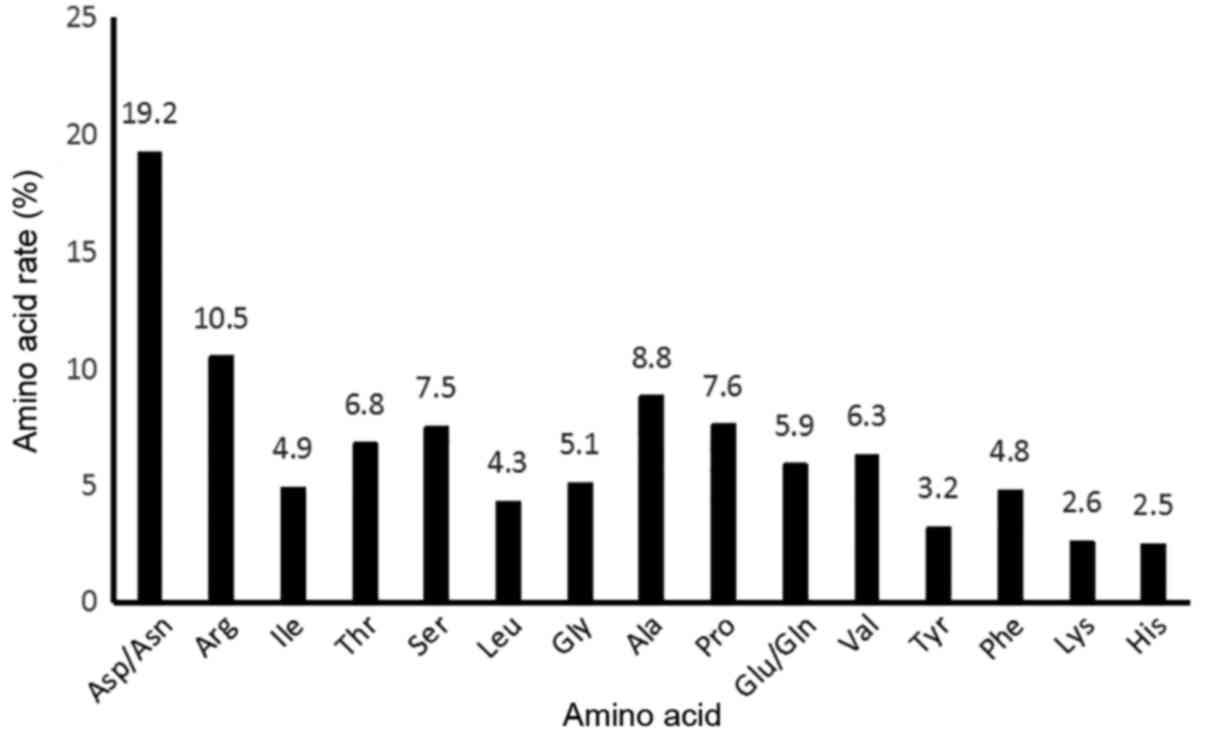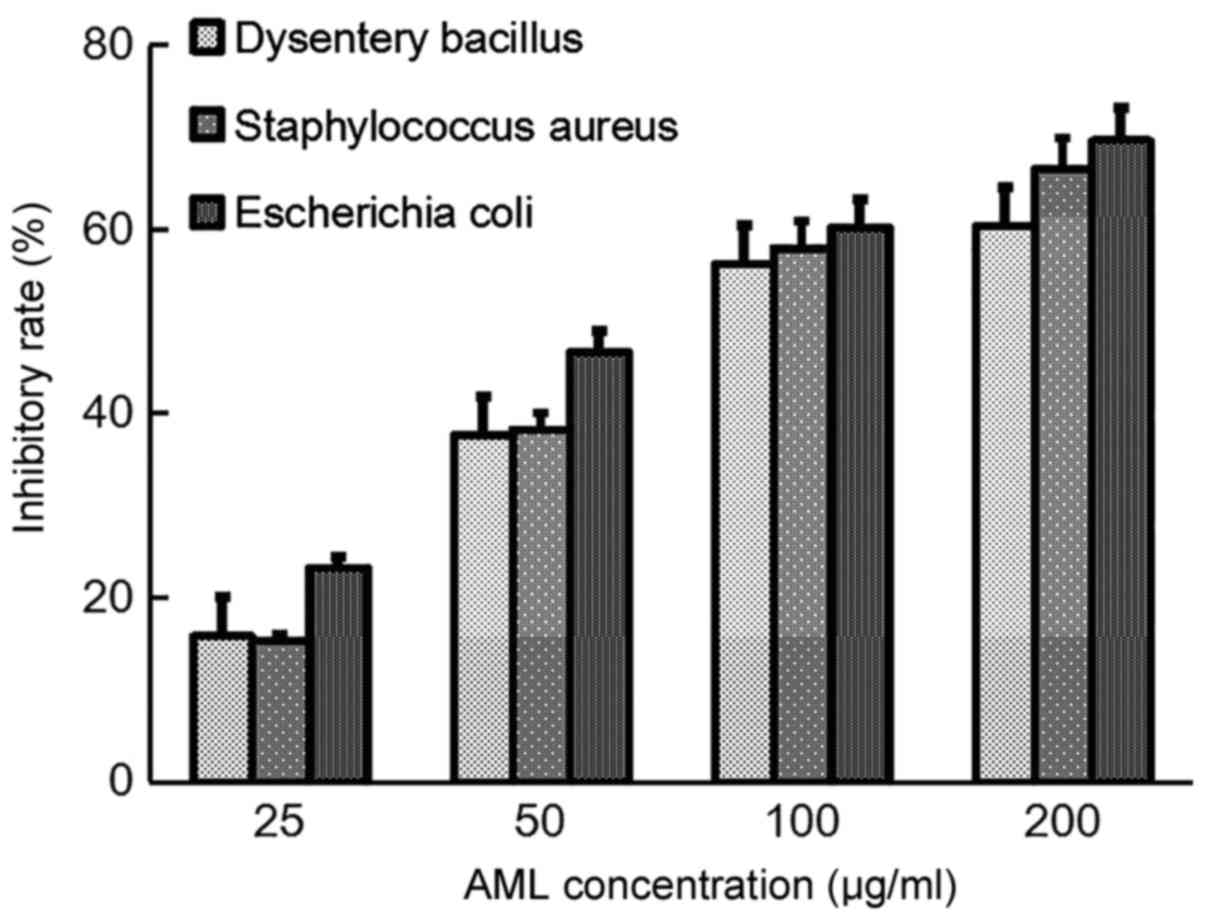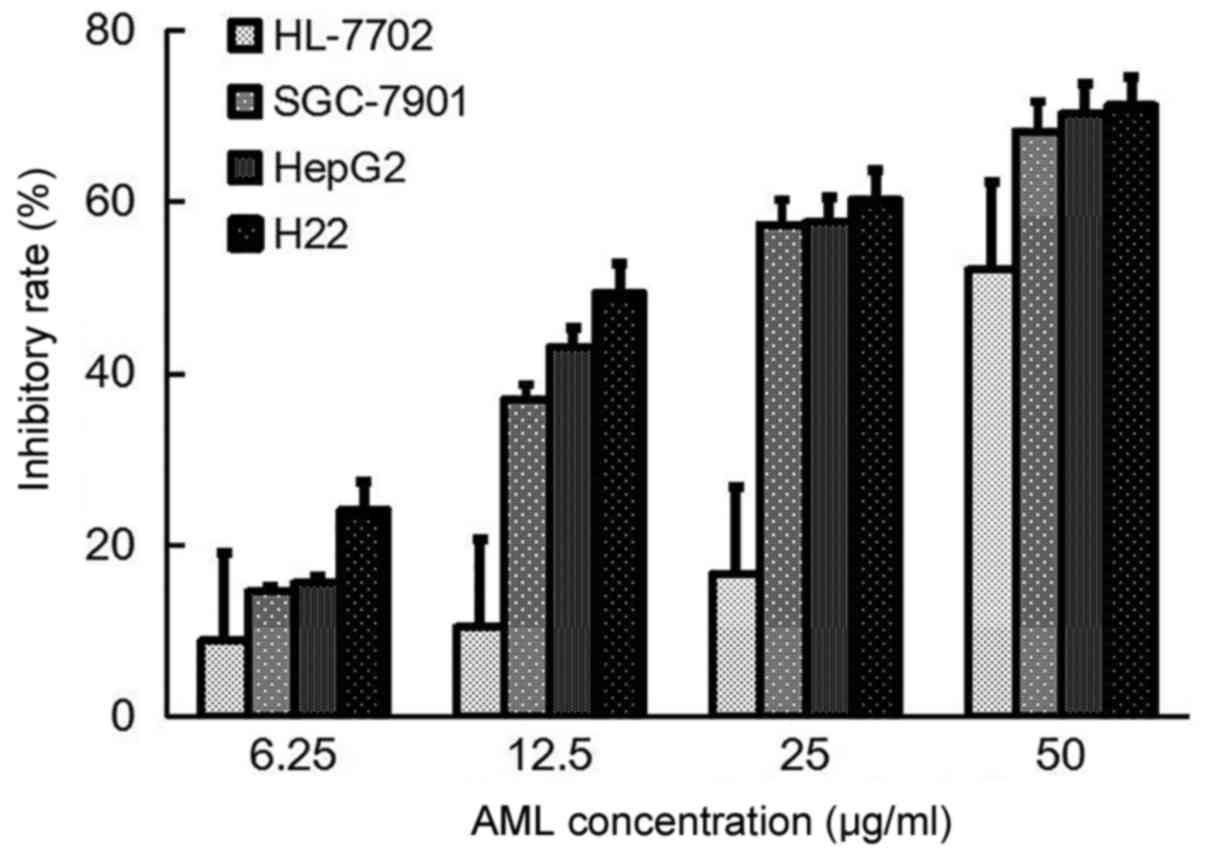Preparation of Astragalus membranaceus lectin and evaluation of its biological function
- Authors:
- Published online on: July 18, 2018 https://doi.org/10.3892/br.2018.1132
- Pages: 345-349
Abstract
Introduction
Astragalus membranaceus has been used historically in China for its apparent medicinal functions. Astragalus membranaceus in isolation, combined with other drugs or as a food supplement may promote health and immune balance (1). Modern pharmacological research has indicated that Astragalus membranaceus has various effects including in regulating the immune system, antioxidant function, in promoting hematopoiesis and in regulating metabolism, among others, and that it could protect endothelial cells subjected to hypoxia-reperfusion by inhibiting lipid peroxidation and enhancing scavenging of oxygen free radicals (2). Studies have also suggested that Astragalus membranaceus may regulate the immune system, inhibit cell mitosis and inhibit the growth of mouse leukemia and lymphadenoma tumor cells by activating mouse B cells and macrophage cells (2,3). The biological activity of Astragalus membranaceus may be due to the functions of its composite proteins, polysaccharides and flavonoids. However, there are few studies on the biological activities of the putative functional proteins of Astragalus membranaceus, and its mechanism of action remains unclear. Therefore, it is of interest to study the effects of proteins extracted from Astragalus membranaceus in terms of potential Antitumor and anti-antibacterial mechanisms.
Lectin has various biological functions, which have become increasingly recognized by previous studies (4–8). It is a type of non-immune glycoprotein that can interact with carbohydrate in a reversible and specific manner. Lectin contains a variable amino acid sequence, and is widely distributed in microbes, virus' and plants (9). The specificity of lectin extends not only to sugar-binding activity but also to function, structure and tissue expression (10). Certain studies have revealed that lectin exhibits various biological activities, including insecticidal activity (4), antifungal action (5), Antitumor effects (6), antivirus action (7) and immunomodulatory effects (8). Furthermore, it has been identified that lectin could be applied in host defence and in the treatment of various diseases including cancer (11,12).
At present, to the best of our knowledge, there are no reports on the abstraction or functions of lectin from the seeds of Astragalus membranaceus. Therefore, in the present study, Astragalus membranaceus lectin (AML) was abstracted, purified and resolved, and its biological activities examined to provide experimental support for the application of Astragalus membranaceus as a therapeutic remedy.
Materials and methods
Materials and samples
The seeds of Astragalus membranaceus were obtained from Shanxi Academy of Agricultural Sciences (Taiyuan, China). Human blood samples (1 ml each of two type A samples, two type B samples, two type AB samples and two type O; all 8 subjects were male, aged 20-40 years old and disease-free) were collected by the Chinese Medicine Hospital of Shanxi Province (Taiyuan, China). Experimental animals were supplied by the animal laboratory centre of Shanxi Medical University (Taiyuan, China). A total of 5 male Japanese White rabbits (8 months old, weight 4-5 kg), 10 C57 male mice (5 weeks old, weight 20-22g) and 10 SD male rats (2.5 months old, weight 350-380 g) were used to collect blood samples, and were housed in a specific pathogen-free (SPF) room under controlled temperature and humidity. A 12-h light/dark cycle was maintained. A HiTrap SP XL anion exchange column and Superdex G25 gel filtration column were purchased from GE Healthcare (Uppsala, Sweden). Fetal bovine serum (FBS) and RPMI-1640 medium were sourced from Sigma-Aldrich (Merck KGaA, Darmstadt, Germany). All solvents used in high-performance liquid chromatography were of chromatography grade, and all other reagents were of the highest purity available.
All subjects whose blood was collected gave sign informed consent for the use of their samples for research purposes. All human and animal protocols were performed according to the Guide for the Care and Use of Laboratory Animals (13) and approved by the Ethics Committees of the Chinese Medicine Hospital of Shanxi Province (Taiyuan, China) and the Chinese Academy of Medical Sciences (Beijing, China).
Extraction and purification of AML
The seeds of Astragalus membranaceus were ground and treated with acetate buffer (pH 5.0) for 24 h at 4°C, and then centrifuged at 10,000 × g and 4°C for 30 min. (NH4)2SO4 was added into the supernatant to 80% saturation and stirred for 4 h at 4°C, followed by centrifugation at 12,000 × g and 4°C for 30 min. The supernatant was discarded and the remaining pellet was precipitated after dissolving with 20 mM Tris-HCl buffer (pH 7.0), and then centrifuged at 10,000 × g and 4°C for 30 min. The supernatant was used to confirm protein content and hemagglutination activity. A two-step chromatography method was used to collect AML. Crude astragalus seed extracts dissolved in 2 ml 20 mM Tris-HCl buffer (pH 7.0) were loaded onto a HiTrap SP XL column, then loaded onto a Superdex G-25 column and eluted by 0.5 M NaCl in 20 mM phosphate-buffered saline (PBS), at a flow rate of 0.5 ml/min, in an AKTA™ Explore protein purification system (GE Healthcare) at room temperature. The bicinchoninic acid assay method was used to detect the level of AML.
Polyacrylamide gel electrophoresis (SDS-PAGE)
According to the method reported by Laemmli (14), the separation gel and spacer gel concentrations were 12.5 and 4.0% respectively. A total of 15 µl protein was loaded per lane. The gel was stained with Coomassie brilliant blue R250 for 1 h at room temperature, and then the formula weight of the protein band was confirmed by a Gel imaging analysis system (Bio-Rad Gel DocXR with Quantity One v4.62 software; Bio-Rad Laboratories, Inc., Hercules, CA, USA).
Analysis of coagulation activity of AML
Rabbit blood (0.5 ml) was collected via the auricular vein, and mouse and rat blood (0.5 ml) were collected via orbital puncture. The coagulation activity of AML was detected in microtitration V plates (25 µl). The AML (1 mg/ml) was mixed with 25 µl of 2% whole blood in normal saline, and then incubated at room temperature until the cells were all deposited in the wells of the blank group (blood samples not mixed with AML). Agglutination activity was determined from the detection of agglutinated erythrocytes by naked eye, and 1/2n (with n being the number of wells exhibiting an agglutination reaction) was presented as the agglutination titer (15).
Detection of PH and thermal stability of AML
To detect the influence of pH on the AML, AML was dissolved in Cl at pH 2.4-3.0 and NaOH at pH 11.7-12.2. Incubation was performed for 30 min at room temperature to neutralize the solution, and coagulation activity was detected by the above method. To detect the thermal stability of AML, the protein (1 mg/ml) was incubated at different temperatures (25-80°C) for 30 min, then placed immediately on ice for 5 min, and its coagulation activity was detected.
Detection of metal ion stability of AML
A 20 mM EDTA-AML solution (1 mg/ml AML initial concentration) was dialyzed and its coagulation activity was detected. Following dialysis, the solution was added into 10 mM Cu2+, Mg2+ or Zn2+, and its coagulation activity was detected.
Detection of sugar content of AML
The sugar content of 1 mg/ml AML was detected by the phenol-sulfuric acid method (16), and its optical density (OD) value was measured at 490 nm. Anhydrous glucose was chosen as the standard. A total of 0.5 ml sample containing 2-25 µg sugar was selected, mixed with 0.3 ml 5% phenol solution followed by 1.8 ml concentrated sulfuric acid, and its OD value was detected at 490 nm. Sugar content of AML was determined from the standard curve. The sugar content was the abscissa, and the OD value the ordinate.
Detection of amino acid content of AML
A total of 1 mg/ml AML was dissolved in 6 M HCl, hydrolyzed at 100°C for 24 h, and analyzed using a Germany Manmerbor A300 Automatic amino acid analyser (MembraPure GmbH, Hennigsdorf, Germany).
Antibacterial activity of AML
Serial dilution of liquid nutrient medium was conducted to detect the antibacterial activity of AML, and the medial lethal dose of AML against bacteria was screened according to preliminary results (unpublished). Using four sterile tubes, 1 ml broth culture (tryptone 10 g/l, yeast extract 5 g/l, NaCl 10 g/l) and 1 ml AML solution were mixed in one tube, from which 1 ml solution was isolated added into the second tube until the fourth tube; the final concentrations of AML were 25, 50, 100 and 200 µg/ml. A tube containing 1 ml broth culture and 1 ml aseptic water was used as a control. Into each tube 50 µl bacterial liquid (106 cells/ml in broth culture) containing Bacillus dysenteriae (B. dysenteriae), Staphylococcus aureus (S. aureus) or Escherichia coli (E. coli) (all from China General Microbiological Culture Collection Center, Beijing, China) was added, mixed and cultured in a 37°C incubator. A sixth tube was designated a zero tube, into which 1 ml broth culture, 1 ml aseptic water and 50 µl normal saline were added. After 24 h, the absorbance value of each tube was observed at 600 nm. Mean absorbance was calculated from three replicate measurements. The half maximal inhibitory concentration (IC50) of AML to each test bacteria was calculated according to the formula IC50=Ilg-1{Xm-I[ΣP-(3-Pm-Pn)/4]} (17), where Xm: the logarithmic value of the maximum concentration; i: the logarithmic value of the ratio of maximum dose to current dose; ΣP: the sum of the growth inhibition rate of each group; Pm: the maximum positive reaction rate; Pn: the minimum positive reaction rate.
Antitumor activity of AML
A Cell Counting Kit-8 (CCK-8) assay (Dojindo Molecular Technologies, Inc., Kumamoto, Japan) was used to analyze the antitumor activity of AML. SGC-7901, HepG2, H22 and HL-7702 cells (BeNa Culture Collection, Beijing, China) in logarithmic growth phase were selected to prepare cell suspensions of 1×106 cell/ml, which were seeded into 96-well plates, with three repeats per cell sample. The cells were cultured in a 5% CO2, 37°C incubator for 2 h, after which PBS was added with different concentrations of AML (6.25, 12.50, 25.00 and 50.00 µg/ml). The cells were further cultured in the 37°C, 5% CO2 incubator for 12, 20 and 24 h respectively, after which 10 µl CCK-8 was added and cells were incubated for another 4 h prior to measurement at 570 nm. The IC50 of AML to each cell line was calculated according to the above formula.
Results
Abstraction and identification of AML
Following rough abstract, ammonium sulfate precipitation and dialysis, the crude proteins were purified by an AKTA Explore system with HiTrap SP XL and Superdex G25 columns. Proteins were obtained weighted 67 kDa by SDS-PAGE (Fig. 1).
Detection of agglutination titer
The hemagglutination effect of AML on human and animal erythrocytes was as follows: Human (A type), 1/29; human (B type), 1/28; human (AB type), 1/28; human (O type), 1/210; rat, 1/29; mouse, 1/28; rabbit, 1/210. At the initial concentration of 1 mg/ml, 1/28=3.91 µg/ml, 1/29=1.95 µg/ml and 1/210=0.97 µg/ml (data not shown).
PH and thermal stability of AML
The AML exhibited minor thermal stability: When it was heated to 64°C, it exhibited normal coagulation activity; while the temperature increase from 64 to 70°C caused a marked decline in activity, and activity was no longer apparent at 80°C. By contrast, AML exhibited considerable pH stability, with normal coagulation activity observed at pH 2-13. At pH 0-1, activity declined to ~50% and at pH 14 was undetectable (data not shown).
Influence of metalions on the agglutination activity of AML
Following dialysis of AML using 20 mM EDTA, no apparent changes were observed in its agglutination activity. Its activity was also unchanged following the addition of 20 mM Cu2+, Mg2+ or Zn2+; the titers of agglutination activity were 1/210 for Cu2+, 1/210 for Mg2+ and 1/29 for Zn2+. Initial concentration was 1 mg/ml; 1/29=1.95 µg/ml and 1/210=0.97 µg/ml. Therefore, the agglutination activity of AML had no apparent association with the presence of the three metal ions (data not shown).
Sugar content of AML
The sugar content of AML was determined to be 16.4% (Fig. 2).
Amino acid content of AML
AML contained 15 types of amino acid, among which the majority were charged and polar amino acids, accounting for ~70%, while the remaining 30% were hydrophobic amino acids. The content of Asp/Asn and Arg, as amino acids associated with immunity (18), was relatively high, nearing 30% (Fig. 3).
Antibacterial activity of AML
The inhibition ratios of different concentrations of AML indicated a dose-dependent effect on the three test bacteria. The IC50 for B. dysenteriae, S. aureus and E. coli were 85.4, 80.2 and 65.3 µg/ml, respectively (Fig. 4).
Antitumor activity of AML
The inhibition ratios of different concentrations of AML suggested a dose-dependent effect on the three tumor cell lines and normal liver cells. The IC50s for SGC-7901, HepG2, H22 and HL-7702 were 19.6, 19.6, 15.5 and 45.1 µg/ml, respectively. Therefore, compared with its effect on the tumor cells, AML exhibited lower cytotoxicity against normal cells, which confirmed that AML had inhibitory effects on the three tumor cell lines (Fig. 5).
Discussion
In the present study, AML was extracted, separated and purified from the seeds of Astragalus membranaceus via buffer extraction, ammonium sulfate precipitation, dialysis and laminar flow analysis with HiTrap SP XL ion exchange and Superdex G25 solvent resistant columns. Its molecular weight was analyzed using SDS-PAGE and determined to be ~67 kDa; furthermore, its sugar content was 16.4% which differed from that reported previously of 10.7% (19) and it contained 15 types of amino acid, of which the majority were charged and polar amino acids (~70%), with the remaining portion being hydrophobic amino acids (~30%). The content of Asp/Asn and Arg, associated with immunity, was relatively high and nearing 30%. The properties of AML including coagulation activity, pH and temperature as well as metal ion stability were further analyzed, and its antibacterial and Antitumor activities were studied. Results indicated that AML exerted stimulatory effects on the agglutination of 4 human blood types and mouse, rat and rabbit erythrocytes, particularly on human blood type O and rabbit erythrocytes. The AML exhibited resistance to three types of metal iron, and its thermal denaturation temperature was over 64°C. AML had preserved total hemagglutination activity at pH 2-13, despite previous studies indicating that hemagglutination activity gradually weakened when pH >9 (20,21); the current data indicates that this novel lectin has a more stable pH than previously proposed, as a suitable precondition for later drug development. Additionally, AML exhibited inhibitory effects on three test bacteria, including B. dysenteriae, S. Aureus and E. coli, for which the corresponding IC50s were all <100 µg/ml. AML also exerted inhibitory effects on the growth of SGC-7901, HepG2 and H22 cells, contrasting to its less toxic effect on HL-7702 cells, although its antitumor mechanism was unclear and requires further study.
Acknowledgements
Not applicable.
Funding
The current work was supported by the Natural Science Foundation of Shanxi Province (grant no. 20170110) and the Scientific Research Project of the Health Planning Committee of Shanxi (grant no. 201601083).
Availability of data and materials
All data described in the article are available upon request from the corresponding author.
Authors' contributions
CZB contributed to conception and design of the study; to acquisition, analysis and interpretation of the data; and to drafting of the manuscript. JQH, XLH and MLF each contributed to acquisition of the data and to revision of the manuscript. MLF contributed to analysis and interpretation of the data as well as to revision of the manuscript.
Ethics approval and consent to participate
The study protocol complied with the Guide for the Care and Use of Laboratory Animals and was approved by the Ethics Committees of the Chinese Medicine Hospital of Shanxi Province (Taiyuan, China). Written informed consent was obtained from all subjects.
Consent for publication
All participants involved in this research agreed to the publication of any associated data and accompanying images.
Competing interests
The authors declare that they have no competing interests.
References
|
Jin M, Zhao K, Huang Q and Shang P: Structural features and biological activities of the polysaccharides from Astragalus membranaceus. Int J Biol Macromol. 64:257–266. 2014. View Article : Google Scholar : PubMed/NCBI | |
|
Shao BM, Xu W, Dai H, Tu P, Li Z and Gao XM: A study on the immune receptors for polysaccharides from the roots of Astragalus membranaceus, a Chinese medicinal herb. Biochem Biophys Res Commun. 320:1103–1111. 2004. View Article : Google Scholar : PubMed/NCBI | |
|
Cho WC and Leung KN: In vitro and in vivo Antitumor effects of Astragalus membranaceus. Cancer Lett. 252:43–54. 2007. View Article : Google Scholar : PubMed/NCBI | |
|
Vandenborre G, Smagghe G and Van Damme EJ: Plant lectins as defense proteins against phytophagous insects. Phytochemistry. 72:1538–1550. 2011. View Article : Google Scholar : PubMed/NCBI | |
|
de Vasconcelos MA, Cunha CO, Arruda FV, Carneiro VA, Mercante FM, do Nascimento Neto LG, de Sousa GS, Rocha BA, Teixeira EH, Cavada BS, et al: : Lectin from Canavalia brasiliensis seeds (ConBr) is a valuable biotechnological tool to stimulate the growth of Rhizobium tropici in vitro. Molecules. 17:5244–5254. 2012. View Article : Google Scholar : PubMed/NCBI | |
|
Balzarini J, Neyts J, Schols D, Hosoya M, Van Damme E, Peumans W and De Clercq E: The mannose-specific plant lectins from Cymbidium hybrid and Epipactis helleborine and the (N-acetylglucosamine)n-specific plant lectin from Urtica dioica are potent and selective inhibitors of human immunodeficiency virus and cytomegalovirus replication in vitro. Antiviral Res. 18:191–207. 1992. View Article : Google Scholar : PubMed/NCBI | |
|
Zuo Z, Fan H, Wang X, Zhou W and Li L: Purification and characterization of a novel plant lectin from Pinellia ternata with antineoplastic activity. Springerplus. 1:132012. View Article : Google Scholar : PubMed/NCBI | |
|
Peumans WJ and Van Damme EJ: Lectins as plant defense proteins. Plant Physiol. 109:347–352. 1995. View Article : Google Scholar : PubMed/NCBI | |
|
Kaltner H, García Caballero G, Ludwig AK, Manning JC and Gabius HJ: From glycophenotyping by (plant) lectin histochemistry to defining functionality of glycans by pairing with endogenous lectins. Histochem Cell Biol. 149:547–568. 2018. View Article : Google Scholar : PubMed/NCBI | |
|
Liu XQ, Wu H, Yu HL, Zhao TF, Pan YZ and Shi RJ: Purification of a lectin from Arisaema erubescens (Wall.) schott and its pro-inflammatory effects. Molecules. 16:9480–9494. 201111 View Article : Google Scholar : PubMed/NCBI | |
|
Ye XY, Ng TB, Tsang PW and Wang J: Isolation of a homodimeric lectin with antifungal and antiviral activities from red kidney bean (Phaseolus vulgaris) seeds. J Protein Chem. 20:367–375. 2001. View Article : Google Scholar : PubMed/NCBI | |
|
Heinrich EL, Welty LA, Banner LR and Oppenheimer SB: Direct targeting of cancer cells: A multiparameter approach. Acta Histochem. 107:335–344. 2005. View Article : Google Scholar : PubMed/NCBI | |
|
Bruce A: Guide for the Care and Use of Laboratory Animals. National Academies Press; Washington: pp. 85–123. 1996 | |
|
Laemmli UK: Cleavage of structural proteins during the assembly of the head of bacteriophage T4. Nature. 227:680–685. 1970. View Article : Google Scholar : PubMed/NCBI | |
|
Qin XZ, Yang XP and Chen J: Hemagglutinins of higher fungi in Altay. Xinjiang Nongye Kexue. 53:142–148. 2016.(In Chinese). | |
|
Dubois M, Gilles KA, Hamilton JK, Rebers PA and Smith F: Colorimetric method for determination of sugars and related substances. Anal Chem. 28:350–356. 1956. View Article : Google Scholar | |
|
Chou TC: The median-effect principle and the combination index for quantitation of synergism and antagonism. Synergism and Antagonism in Chemotherapy. Chou TC and Rideout DC: Academic Press; San Diego, CA: pp. 61–102. 1991 | |
|
Barbul A, Sisto DA, Wasserkrug HL and Efron G: Arginine stimulates lymphocyte immune response in healthy human beings. Surgery. 90:244–251. 1981.PubMed/NCBI | |
|
Zhu LF, Yan QJ, Jiang ZQ and Huang LH: Isolation and purification of a lectin from roots of Astragalus membranaceus. Chin Tradit Herbal Drugs. 41:714–717. 2010. | |
|
Kaur A, Singh J, Kamboj SS, Sexana AK, Pandita RM and Shamnugavel M: Isolation of an N-acetyl-D-glucosamine specific lectin from the rhizomes of Arundo donax with antiproliferative activity. Phytochemistry. 66:1933–1940. 2005. View Article : Google Scholar : PubMed/NCBI | |
|
Vaz AF, Costa RM, Melo AM, Oliva ML, Santana LA, Silva-Lucca RA, Coelho LC and Correia MT: Biocontrol of Fusarium species by a novel lectin with low ecotoxicity isolated from Sebastiania jacobinensis. Food Chem. 119:1507–1513. 2010. View Article : Google Scholar |



